|
A BLAST FROM THE PAST PART TWO, BY DAVID BICKER
I’ve had the opportunity to scan in a few pictures of models that I built in the 90’s, most of which didn’t survive my use or several house moves but may be of interest:
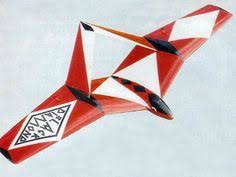
BLACK DIAMOND
One of Trevor Hewson’s brilliant creations (pictured above) & great fun to fly. The unorthodox shape is a conversation point & it even looks strange in the air. From the side view it looks like a flying boot, from behind or in front it shows off the diamond shaped “hole” under the tail fins that join together at the tips, above the fuselage.
This was one of my earliest builds & got a lot of hard use. I regret that it didn’t survive my poor flying skills & as I still have the original plans I intend to build another one at some stage in the future.
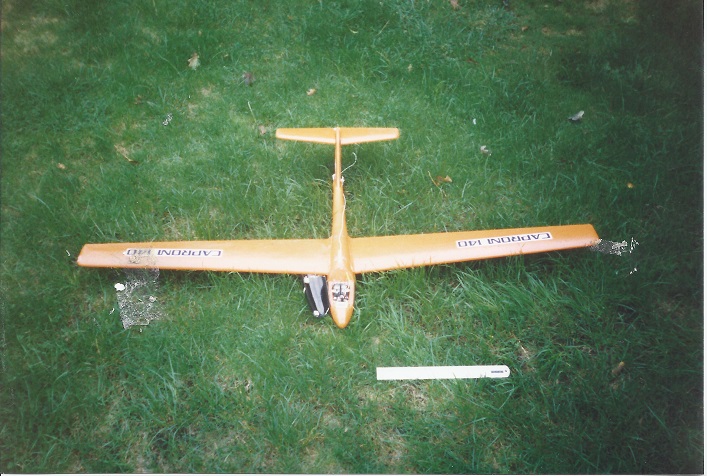
CAPRIONI
This was a chuck glider bought from Westbourne Model Shop & converted with 2 standard servos & a 500mah square Ni-Cad battery pack to rudder & elevator control. It used a mini Micron receiver on 35mhz. The wings were plug-in & not held well enough for the job so I devised a system of tubes made from servo snake tubing through the fuselage & wing roots that were held in with wire pins. It worked quite well, but took damage easily if you hit a Cowslip on landing!
As you can see from the 12” ruler shown for scale it had about a 40” wingspan & the model was of a CAPRONI A21S-J. Thn converted model was made of light-weight polystyrene & couldn’t handle much wind but I flew it a lot as it fitted on any car’s parcel shelf & got taken wherever I flew.
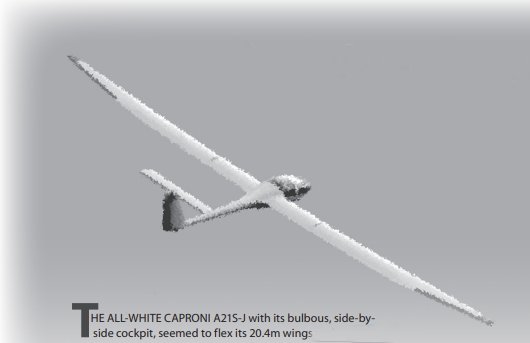
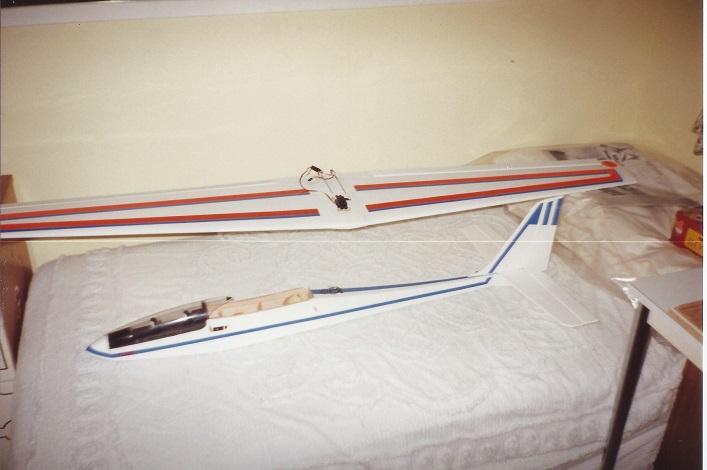
FLAIR FLEDGLING
I don’t remember much about this model. It was a 3 channel trainer of about 6 feet wingspan. I can’t remember if it had a balsa sheeted foam wing like the Heron that I still have in my loft. Any info on it would fill a gap in the history of this model. I think it was an unimpressive model that didn’t get used too much. Probably why I moved onto the flair Heron – which turned out to be a bit of a plank to fly too…
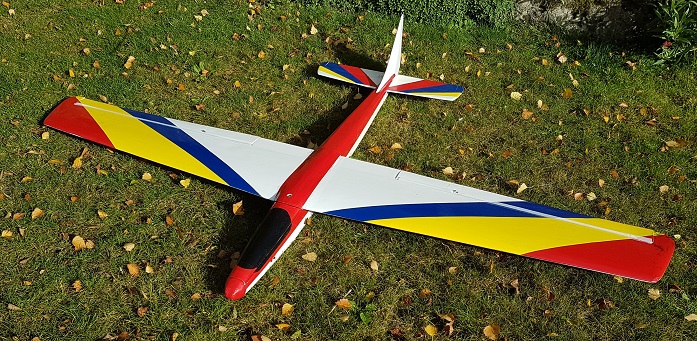
FLAIR HERON, 67” SPAN BY DAVID BICKER
I originally built this model 30 years back around 1990, so I was expecting a lot of restoration work when I got it out of the loft. A lot of the coverings were peeling back & it looked very tatty. On close inspection the Balsa / Light Ply fuselage was sound, the veneered white polystyrene wing completely undamaged, but there was some warping in the ailerons which are long & thin on this model, so susceptible to changes in heat in the loft.
To my surprise the iron-on covering ironed back on with a few exceptions. It's a bit of a patchwork quilt of covering , but I didn't want to spend out on a complete re-cover until I knew that the model flew well enough to be worth keeping. One control horn on an aileron needed replacing & I didn't like the way that I'd done the snakes to the ailerons either, with bowden braided cable soldered to metal wire ends to fit the single centrally mounted servo in the wing. It sure dates it that the servos were all Futaba 148's too. They all worked fine so weren't replaced (in the fus).
However I had decided to try to improve the flying characteristics of this plane by fitting mini servos for each aileron so that I could dial in some differential to cut down yaw characteristics. I used MG90S Micro Metal Gear 9g Servos & built them into the veneer sheeted white foam wing a few inches behind the aileron horns where the wing was deep enough to take them. I cut a narrow slot in the wing skin & buried the wiring, then bonded the removed section back in. While I was programming the TX I also added a rates switch as I had no idea how well it was going to fly & wanted the option to increase/decrease travel if needed in-flight. The original travel was 10mm up & therefore down as well - with the down causing drag. So I guessed & set the Up to 15mm & the Down to 7mm, but rated it to Up 10mm Up & 5MM Down just in case that was too much.
When I flew it years ago with the single aileron servo set-up I remember the plane being a bit of a brick to fly so adding differential would hopefully improve things.
The colour scheme was one that I originally copied off the front of the box that it came in. Nowadays people may look at it as "the NHS plane" or the other very similar flag - but it was just a smart colour scheme when I did it 30 years ago!
Luckily even 30 years ago my OCD had kicked in so although I didn't have the plans, paperwork or the box that it came in I'd written all of the control surface travel measurements & CoG in Biro in the inside of the fuselage. My usual rule of thumb of balancing slope soarers 30% back from the leading edge would have been 15mm too far forwards. I'm sure that's because of the slightly delta leading edge of the wing (that's what I'm going to call it anyway).
When it came to balancing I found out why it had flown like a brick - when I removed a large chunk of lead out of the nose! I am now using a tiny very light 2.4ghz RX (a CR-8D) instead of a full sized 35mhz Futaba Rx which would have been in the model before. The new wing servos are behind the CoG whereas the original single servo was in front of it. So quite a few weight changes. It's now 3 1/2 lbs all-in, about 8oz lighter than it was before the resurrection.
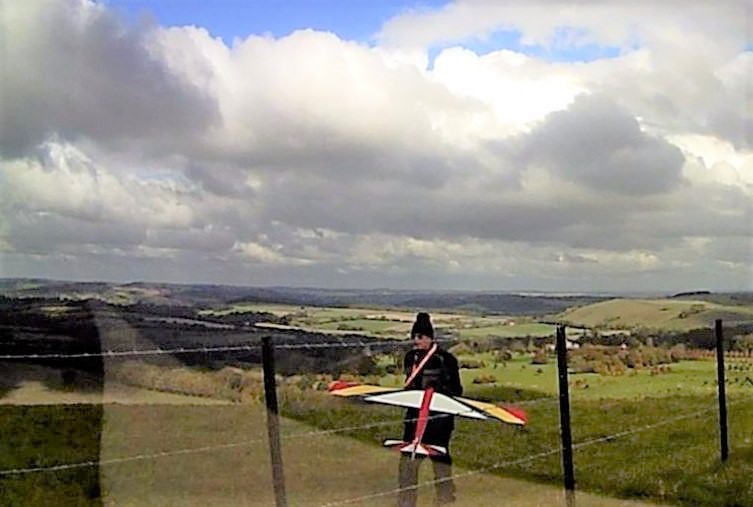
Finally it was ready & just waiting for a suitable day to maiden it. A reasonably suitable 10mph NE wind took me to the more difficult NE slope at Win Green. As I didn't know how it would handle I tried a few other planes in the air first - 88" Precedent Electrafly, Zagi LE & then the X-Fire. Once you had got out beyond the turbulence from the row of trees at the bottom of the field below the bowl the air smoothed out & became enjoyable. There was the usual Buzzard & in the end a total of 3 Red Kites that are resident around the Win Green area that arrived in the lift. One of the red Kites seems to have a fascination with my brightly coloured Zaggi & again followed it around for some time. He gave up following my planes when I powered up the X-Fire (which slopes very well with the motor off) & accelerated away & above him. I think that he decided that he couldn't compete with that! Another flyer with a bright lemon green Zaggi joined me for a while & enjoyed being followed around by the Red Kite too.
The time came to try the Heron & I it launched easily but I soon realised that with the rates on I had little control over the ailerons & was struggling, so I quickly turned off the rates & it came life & started to respond well to control inputs. It climbed well & banks smoothly & loops well but in that current trim set-up it did very ponderous rolls but completed the task eventually. Overall it seems well trimmed & it climbs rapidly in lift so it looks pretty well sorted.
Back home I have dialled in 20mm Up with 10 mm Down & rates at 10mm / 7mm in case I find it too lively next time so that I can switch it back to how it first flew well.
Overall I enjoyed flying it & will make use of it, but I have yet to master how to program in the Spoilerons that I want to dial in. At least I got Rates to work on the ailerons.
|